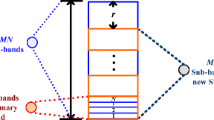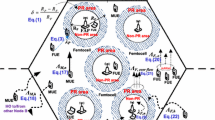Abstract
In the micro-cell-based PCS networks, due to the high user mobility, handoffs occur more frequently. Hence, the classical assumptions, such as the exponential assumptions for channel holding time and call inter-arrival time, may not be valid. In this paper, we investigate the call blocking performance for PCS networks using a semi-analytic and semi-simulation approach. We first construct a simulation model as the base for our performance study, using which the handoff traffic is studied. Then we present a few possible approximation models from which analytical results for call blocking performance metrics can be obtained and compared with the simulation results. We show that for a certain parameter range, such approximations may provide appropriate results for call blocking performance. Finally, using the simulation model, we investigate how various factors, such as the high moments, the variance of cell residence time, mobility factors and the new call traffic load affect the call blocking performance. Our study shows that all these factors may have a significant impact on call blocking performance metrics such as call blocking probability, call incompletion probability and call dropping probability. This research provides a strong motivation for the necessity of reexamining the validity of analytical results obtained from classical teletraffic theory when dealing with the emerging wireless systems.
Similar content being viewed by others
References
F. Barcelo and S. Bueno, Idle and inter-arrival time statistics in public access mobile radio (PAMR) systems, in: Proc. of IEEE Globecom'97, Phoenix, AZ, November 1997.
F. Barcelo and J. Jordan, Channel holding time distribution in cellular telephony, in: The 9th Internat.Conf. on Wireless Communications (Wireless'97), Vol. 1, Alberta,Canada, 9-11 July 1997, pp. 125-134.
I. Chlamtac, Y. Fang and H. Zeng, Call blocking analysis for PCS networks under general cell residence time, in: WCNC'99, New Orleans, September 1999.
E. Chlebus and W. Ludwin, Is handoff traffic really Poissonian? in: IEEE ICUPC'95, Tokyo, Japan, 6-10 November 1995, pp. 348-353.
D.R. Cox, Renewal Theory (Wiley, New York, 1962).
E. Del Re, R. Fantacci and G. Giambene, Handover and dynamic channel allocation techniques in mobile cellular networks, IEEE Transactions on Vehicular Technology 44 (May 1995) 229-237.
Y. Fang, Hyper-Erlang distribution and its applications in wireless and mobile networks, Wireless Networks (WINET) 7(3) (May 2001) 211-219.
Y. Fang and I. Chlamtac, Teletraffic analysis and mobility modeling for PCS networks, IEEE Trans-actions on Communications 47(7) (July 1999) 1062-1072.
Y. Fang, I. Chlamtac and Y.B. Lin, Call performance for a PCS networks, IEEE Journal on Selected Areas in Communications 15(8) (October 1997) 1568-1581.
Y. Fang, I. Chlamtac and Y.B. Lin, Modeling PCS networks under general call holding times and cell residence time distributions, IEEE Transactions on Networking 5(6) (December 1997) 893-906.
Y. Fang, I. Chlamtac and Y.B. Lin, Channel occupancy times and handoff rate for PCS networks, IEEE Transactions on Computers 47(6) (1998) 679-692.
R.A. Guerin, Channel occupancy time distribution in a cellular radio system, IEEE Transactions on Vehicular Technology 35(3) (1997) 89-99.
D. Hong and S.S. Rappaport, Traffic model and performance analysis for cellular mobile radio tele-phone systems with prioritized and non-prioritized handoff procedures, IEEE Transactions on Vehicular Technology 35(3) (1986) 77-92.
C. Jedrzycki and V.C.M. Leung, Probability distribution of channel holding time in cellular telephony systems, in: IEEE Vehicular Technology Conference (VTC'96), 1996, pp. 247-251.
F.P. Kelly, Loss networks, The Annals of Applied Probability 1(3) (1991) 319-378.
Y.B. Lin and I. Chlamtac, Wireless and Mobile Network Architectures (Wiley, New York).
Y.B. Lin, S. Mohan and A. Noerpel, Queueing priority channel assignment strategies for handoff and initial access for a PCS network, IEEE Transactions on Vehicular Technology 43(3) (1994) 704-712.
I. Mitrani, Modeling of Computer and Communication Systems (Cambridge Univ. Press, Cambridge, 1987).
P. Orlik and S.S. Rappaport, A model for teletraffic performance and channel holding time characterization in wireless cellular communication with general session and dwell time distributions, IEEE Journal on Selected Areas in Communications 16(5) (1998) 788-803.
P. Orlik and S.S. Rappaport, On handoff arrival process in cellular communications, in: Proc. of IEEE WCNC'99, New Orleans, September 1999.
M. Rajaratnam and F. Takawira, Hand-off traffic modeling in cellular networks, in: Proc. of Globe-com'97, Phoenix, AZ, November 1997.
M. Rajaratnam and F. Takawira, Nonclassical traffic modleing and performance analysis of cellular mobile networks with and without channel reservation, IEEE Transactions on Vehicular Technology 49(3) (May 2000) 817-834.
M. Sidi and D. Starobinski, New call blocking versus handoff blocking in cellular networks, Wireless Networks 3 (1997) 15-27.
S. Tekinay and B. Jabbari, A measurement-based prioritization scheme for handovers in mobile cellular networks, IEEE Journal on Selected Areas in Communications 10(8) (1992) 1343-1350.
C.H. Yoon and C.K. Un, Performance of personal portable radio telephone systems with and without guard channels, IEEE Journal on Selected Areas in Communications 11(6) (1993) 911-917.
H. Zeng and I. Chlamtac, Handoff traffic distribution in cellular networks, in: WCNC'99, New Orleans, September 1999.
M.M. Zonoozi and P. Dassanayake, User mobility modeling and characterization of mobility patterns, IEEE Journal on Selected Areas in Communications 15(7) (September 1997).
Author information
Authors and Affiliations
Rights and permissions
About this article
Cite this article
Zeng, H., Fang, Y. & Chlamtac, I. Call Blocking Performance Study for PCS Networks under More Realistic Mobility Assumptions. Telecommunication Systems 19, 125–146 (2002). https://doi.org/10.1023/A:1013330625017
Issue Date:
DOI: https://doi.org/10.1023/A:1013330625017




